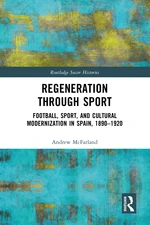This book examines how and why sport in general, and football in particular, entered the country and developed successfully between 1890 and the 1920s, while placing that growth within the context of Spainâs larger historical experience. The introduction of sport in the late 19th century permanently changed the day-to-day lives of thousands of Spaniards. Initially, the countryâs growing urban middle-classes embraced the new activity as they built community identities and were introduced to it through economic and educational connections to foreigners. To justify this, these proponents argued that the adoption of physical education and sport would physically regenerate the nation. In response, well-rounded sporting communities grew, developed medical arguments, and even debated the activityâs appropriateness for different groups like women. As sport spread, it produced the first football clubs around the turn of the century. Subsequently, in the 1910s and early 1920s, football established the structural institutions, like stadiums, stars, regulatory bodies, and a press, that enabled its rapid expansion as a mass consumer activity in the late 1920s. Regeneration through Sport looks at how this process embedded the sport within the national culture and established itself as a politically neutral activity before the Spanish Second Republic, allowing it to become almost ubiquitous today. This book will appeal to researchers, students and scholars alike who are interested in the history of sport, Spain, and European history.
Price history
Dec 2, 2022
€47.02

